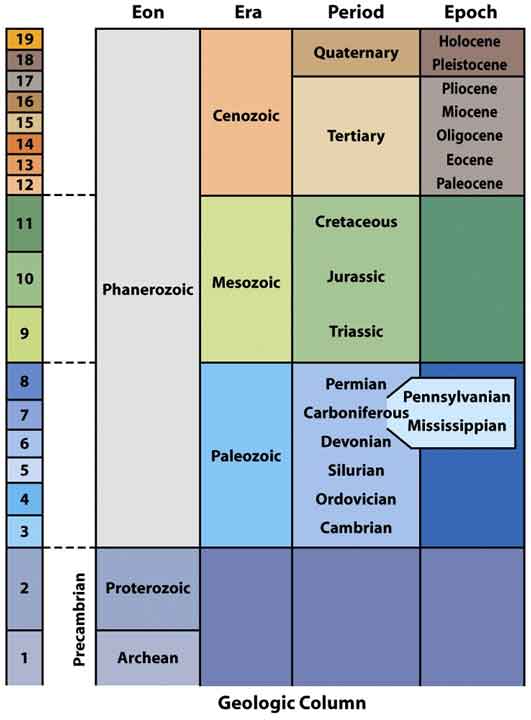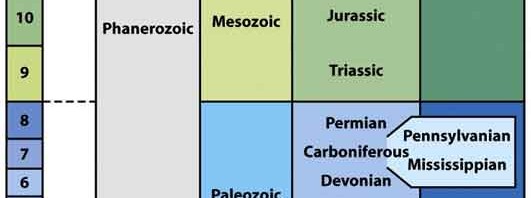Notice
If you get a question wrong, you can still click on the other answers. This will open up hints and explanations (if available), which will provide additional information.Disclaimer: While every reasonable effort is made to ensure that the information provided is accurate, no guarantees for the currency or accuracy of information are made. It takes several proof readings and rewrites to bring the quiz to an exceptional level. If you find an error, please contact me as soon as possible. Please indicate the question ID-Number or description because server may randomize the questions and answers.
Go to: Midterm Exam
Geology (GLGY 201-UCAL) Final Exam
Congratulations - you have completed Geology (GLGY 201-UCAL) Final Exam.
You scored %%SCORE%% out of %%TOTAL%%. With incorrect multiple attempts your score is %%PERCENTAGE%%
Your performance has been rated as %%RATING%%
Question 1 |
A | Dykes are formed primarily due to preexisting weak planes of the country rock. |
B | Higher the friction between a glacier and the ground, faster the migration of the glacier. |
C | Higher the mountains in collisional or convergent orogen, the deeper the crustal root. |
D | Higher the depth of a river, larger the volume of sediment deposition and accumulation on the river bed. |
E | Plate tectonic movement is mostly driven by the energy obtained through the rotation of the Earth. Hint: This is what some scientists thought long time ago. This has been proven to be incorrect. |
Question 2 |
A | It is a bar where ice cold drinks are served only for cool geoscientists. |
B | It is a graphical representation of change in temperature with depth in the lithosphere. |
C | It is an imaginary line that separates the four major layers of atmosphere. |
D | It is a representation of pressure - temperature boundaries which specific minerals may form out of a magma. |
E | It is a line on a map used to separate different air pressures. |
Question 3 |
A | surface erosion. |
B | dendritic network. |
C | drainage erosion. |
D | fracture network. |
E | headward erosion. |
Question 4 |
A | 10 times less |
B | 100 times less |
C | 100 times more |
D | 10 times more |
E | 1 times more |
F | 1 times less |
Question 5 |
A | surtseyan |
B | vulcanian |
C | phreatic |
D | plinean |
E | strombolian |
Question 6 |
A | on overriding plate , landwards |
B | None of the answers are correct. |
C | landwards , on overriding pate |
D | seawards , on the extinct arc |
Question 7 |
A | Aquifers with very high porosity, but very low permeability. |
B | Aquifers with very low porosity and permeability. |
C | Confined aquifers with very high permeability. |
D | Unconfined aquifers with very high permeability. |
Question 8 |
What is 3L on the following diagram? (ID-GLF-20)
Note: DO NOT scroll down to the Geologic Time scale on this page. Answer this question without using any AIDS.
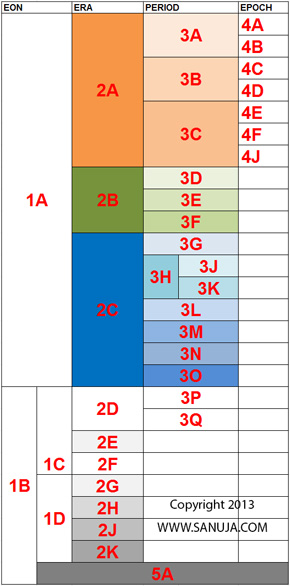
A | Pennsylvanian |
B | Ordovician |
C | Devonian |
D | Triassic |
E | Jurassic |
Question 9 |
A | Principle of Superposition |
B | Principle of Original Horizontality |
C | Theory of Geologic Evolution |
D | Principle of Uniformitarianism |
E | Theory of Plate Tectonics |
Question 10 |
A | Factor of 10,000 |
B | Factor of 20,000 |
C | Factor of 2 |
D | Factor of 3 |
E | Factor of 1 |
Question 11 |
A | Tar |
B | Heating oil |
C | Natural gas |
D | Gasoline |
E | Kerosene |
F | Bottled gas |
Question 12 |
A | Within underwater mudslides |
B | Within fluvial deposits |
C | Within metamorphic rocks |
D | Withing igneous rocks |
E | Within sedimentary rocks |
Question 13 |
A | About 0 to 5 km |
B | About 50 to 70 km |
C | About 30 to 40 km |
D | About 10 to 15 km |
E | About 90 to 100 km |
Question 14 |
A | Reverse fault line |
B | Normal fault line |
C | Valley or topographic depression |
D | Ridge or hill top |
Question 15 |
A | Basin and Range |
B | Himalayas |
C | Hawaiian Islands |
D | Canadian Rockies |
Question 16 |
A | 160 parent isotopes |
B | 125 parent isotopes |
C | 100 parent isotopes |
D | 250 parent isotopes |
E | 40 parent isotopes |
Question 17 |
A | Cooling or heating of air or matter without increasing or decreasing of pressure. |
B | Cooling or heating of air or matter without the addition or subtraction of thermal energy. |
C | Cooling or heating of air or matter without the addition or subtraction of atoms or molecules. |
D | Cooling or heating of air or matter through geologic uplift. |
E | Cooling or heating of air or matter without decreasing or increasing of temperature. |
F | Cooling or heating of air or matter through compression solidification or decompression melting. |
Question 18 |
A | Fungi |
B | Protista |
C | Bacteria |
D | Animalia |
E | Plantae |
Question 19 |
A | About 100 km |
B | About 30 km |
C | About 1 km |
D | About 10 km |
E | About 5 km |
Question 20 |
A | Late Mesozoic |
B | Early Cenozoic |
C | Early Proterozoic |
D | Late Cenozoic |
E | Early Cambrian |
Question 21 |
A | 3.92 Ga |
B | 3.87 Ga |
C | 3.55 Ga |
D | 4.54 Ga |
E | 4.03 Ga |
Question 22 |
A | It measures the rate at which the transport system deposit its load. |
B | It measures the largest clast/sediment size a stream/river can transport. |
C | It measures the volume of sediments transported by a stream/river system. |
D | It measures the rate of sediment supply to a stream/river system. |
E | It measure the flow rate of sediments at a fixed given location. |
Question 23 |
What is 3G on the following diagram? (ID-GLF-39)
Note: DO NOT scroll down to the Geologic Time scale on this page. Answer this question without using any AIDS.

A | Devonian |
B | Jurassic |
C | Cenozoic |
D | Permian |
E | Eocene |
F | Cretaceous |
Question 24 |
A | Change in pressure and temperature in magma underground which eventually leads to fractional crystallization. |
B | Collision of two or more air masses which result in formation of clouds, wind and rain. |
C | Change in stress fields during metamorphism creating a differential stress which result in lineation of minerals. |
D | Movement of tectonic plates that result in formation of new crust due to upwelling of magma. |
E | Forces and events leading to a large structural deformation of the Earth's lithosphere resulting mountain building. |
Question 25 |
A | exosphere |
B | ionosphere |
C | stratosphere |
D | mesosphere |
E | troposphere |
F | thermosphere |
Question 26 |
A | Dissolution |
B | Vesicles and voids within matrix |
C | Inter granular porosity |
D | Reef framework |
Question 27 |
A | Extraction of groundwater in large volumes in a long period of time. |
B | Extraction of groundwater in large volumes in a small period of time. |
C | Injection/addition of water into the ground due to heavy rainfall. |
D | Higher rate of leaking groundwater into rivers and lakes due to higher formation pressures. |
Ref: Dr. Alexander Dutchak Fall 2015 lecture notes.
Question 28 |
A | bent towards the normal |
B | split into several rays |
C | bent away from the normal |
D | be refracted |
E | disintegrate |
Question 29 |
A | They are S-waves that intersects the land surface. |
B | Slower than S-waves but faster than Love waves. |
C | Causes ground to ripple up and down like water waves in a lake. |
D | They are P-waves that intersects the land surface. |
E | Material moves back and forth parallel to the wave direction. |
Question 30 |
A | Volcanic eruptions |
B | Human interference such as construction and nuclear detonations |
C | Magma migration |
D | Sudden changes in mineral structures |
E | Crustal fault slips |
Question 31 |
A | The temperature above which the water is neither a gas nor a liquid. |
B | The temperature below which crystals are first formed. |
C | The temperature above which crystals are first formed. |
D | The temperature below which magma no longer have the ability to erupt out of the volcano. |
E | The temperature below which isotopes are no longer free to move. |
Question 32 |
A | lowering of the groundwater table at the regional scale. |
B | raising of the groundwater table at the regional scale. |
C | lowering of the groundwater table at the global scale. |
D | increased availability of groundwater in shallow wells. |
E | raising of the groundwater table at the global scale. |
Question 33 |
A | headward erosion by one stream causes the stream to intersect another stream. |
B | water levels and flow rates are too high for a river bed to maintain its shape result in collapse of valleys or canyons. |
C | reversing of the flow direction due to change in the direction of slope due to tectonic of other events. |
D | water levels are not high enough to maintain the flow resulting in change in stream direction. |
Question 34 |
A | It occurs when the last member of a given species dies without producing any offspring. |
B | It occurs when the last member of a given family dies without producing any offspring. |
C | It occurs when the last member of a given class dies without producing any offspring. |
D | It occurs when the last member of a given genus dies without producing any offspring. |
E | It occurs when the last member of a given kingdom dies without producing any offspring. |
Question 35 |
A | Active faults |
B | Marginal faults |
C | Blind faults |
D | Crustal faults |
E | Inactive faults |
Question 36 |
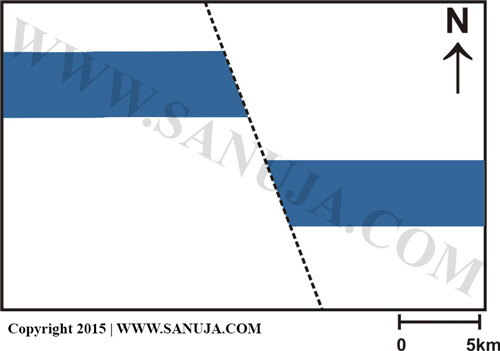
A | Right-lateral strike slip fault |
B | Thrust fault |
C | Reverse fault |
D | Normal fault |
E | Left-lateral strike slip fault |
Question 37 |
A | 125 Ma |
B | 100 Ma |
C | 300 Ma |
D | 250 Ma |
E | 375 Ma |
Question 38 |
A | Wadati-Benioff discontinuity |
B | Wegener discontinuity |
C | Mercalli discontinuity |
D | Mohorovic discontinuity |
Question 39 |
A | It occurs when sediments from deep underground which are formed under high pressure were exhumed in a short period of time. |
B | It occur when the pore water pressure increased enough to push sediment grains apart from each other. |
C | It occurs due to nuclear radiation caused by decomposition of radioactive elements within sediments and minerals. |
D | It occurs as the heat from magma melts the wall rock (country rock) resulting melting of the surrounding. |
E | It occurs when ground shake due to P-wave vibrates sediments hard enough resulting solids behaving like liquids. |
Question 40 |
A | transpiration. |
B | precipitation. |
C | evaporation. |
D | infiltration. |
E | sublimation. |
Question 41 |
A | Joints are planar metamorphic fabrics while faults are planer surfaces of physical separations within rocks. |
B | Joints are usually associated with igneous processes and faults are usually associated with orogenic processes. |
C | Joints only occur in softer materials such as sediments and faults occur in hard rocks. |
D | Joints are much smaller in scale than faults. |
E | Joints are fractures that have no offsets, while faults are fractures with offsets. |
Question 42 |
A | Collisional orogenesis environments |
B | Strike-slip environments |
C | Mid-oceanic ridge environments |
D | Extensional rifting environments |
Question 43 |
A | Resistance of its walls to erosion slumping. |
B | Sediment load of the river/stream. |
C | Its elevation from the sea level. |
D | Flow rate of the water (velocity) and the volume of water. |
Question 44 |
A | change its shape by shortening |
B | change its location |
C | most likely maintain the original mineral composition |
D | retains the primary igneous structures. |
E | change its orientation |
Question 45 |
Note: Do not worry about the vector arrows. This animation was created for 300/500-level structure classes.
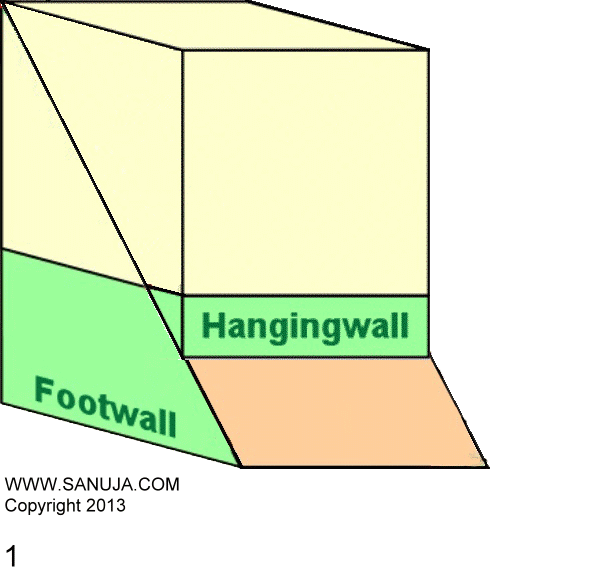
A | Right lateral strike-slip fault |
B | Normal fault |
C | Left lateral strike-slip fault |
D | Not enough information is provided in the question. |
E | Reverse fault |
Question 46 |
A | Pore pressures that holds the grains apart fluctuates causing subsidence during warm summers and uplift during wet winters and springs. |
B | The groundwater must be flowing at a faster rate during wet spring and summer than during winter causing subsurface erosion. |
C | There must be a very large cone of depression directly under the road surface in question causing surface to subside during warm and dry seasons. |
D | Weight of the materials used to construct the road surface is effecting the groundwater pressures in the subsurface. |
Question 47 |
A | Petrified wood |
B | Skeletons |
C | Shell fragments |
D | Amber embedded fossils |
E | Burrows |
Question 48 |
A | Isostasy |
B | Accretion |
C | Orogeny |
D | Induced equilibrium |
E | Mesopause |
Question 49 |
Note: DO NOT scroll down to the Geologic Time scale on this page. Answer this question without using any AIDS.
A | Cambrian |
B | Paleogene |
C | Silurian |
D | Devonian |
E | Cretaceous |
Question 50 |
A | lineation. Hint: This is true, but this is an observation and not a measurement. |
B | stress. |
C | strain. |
D | pressures. |
E | foliations. Hint: This is true, but this is an observation and not a measurement. |
Question 51 |
A | A supercontinent that consisted of today’s South America, Africa, Antarctica, India, and Australia. |
B | The ocean that was once covered the Alberta region, which helped the formation of oil/gas deposits. |
C | A continent in the early Paleozoic Era composed of today’s North America and Greenland. |
D | None of the answers are correct. |
E | A proposed Precambrian supercontinent that existed
around 1 billion years ago. |
Question 52 |
A | Carbon and oxygen |
B | Carbon and nitrogen |
C | Carbon and hydrogen |
D | Carbon, nitrogen and oxygen |
E | Carbon, hydrogen and oxygen |
Question 53 |
A | on the continental shelf |
B | in rift valleys |
C | on the abyssal plain |
D | in oceanic trenches |
Question 54 |
A | They are usually stationary and has been that for since the beginning of the Earth. |
B | They usually coincide with plate boundaries. |
C | They runs parallel to the equator of the Earth. |
D | They only occur in ductile regions. |
E | They are defined by the magnetic forces of the Earth. |
Question 55 |
A | All meandering rivers always from oxbow lakes. |
B | Oxbow lakes are formed as a result of downcutting of the river into soft sediments hence they are unusually deep areas of a river. |
C | A meander that has been cut off yet remains filled with water forms an oxbow lake. |
D | Melting of glaciers due to friction between the ground and itself forms oxbow lakes at the base of the glacier. |
E | Melting of glaciers at the surface (top) due to the heat from sun result in formation of oxbow lakes on top of the glacier itself. |
Question 56 |
A | Seismic waves travel faster in high density mediums. |
B | Seismic waves that enters a faster medium from a slower medium will undergo refraction towards the normal. |
C | Seismic waves were first discovered by Andrija Mohorovicic. |
D | Surface seismic waves are the fastest in terms of travel time. |
E | Seismic waves are able to sustain their energy in softer mediums for a longer period of time. |
Question 57 |
A | An area where geoscientists predicted to have an earthquake in near future. |
B | None of the listed answers are correct. |
C | An area that has been known to have earthquakes in high frequency in the past. |
D | The epicenter of an earthquake. |
E | An area that is damaged by a recent earthquake. |
Question 58 |
A | Equilibrium |
B | Isostasy |
C | Induced stability |
D | Orogeny |
Question 59 |
A | Allegheny Mountains formed before the both of the Appalachian and Grenville orogenies. |
B | Appalachian orogeny is occurred as a result of four separate continental collisions. Hint: Three separate continental collisions. |
C | Appalachian orogeny occurred at the same time as the Grenville orogeny. |
D | Appalachian orogeny occurred after the Grenville orogeny. |
Question 60 |
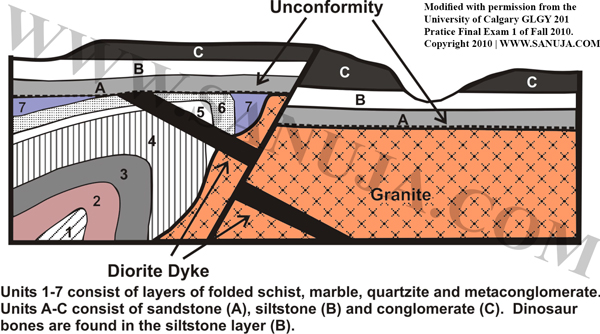
A | Symmetric syncline |
B | Asymmetric syncline |
C | Asymmetric anticline |
D | Overturned syncline |
E | Symmetric anticline |
Question 61 |
A | Brittle deformation |
B | Low pressure and high temperature |
C | Ductile deformation |
D | At extensional settings |
E | High pressure and low temperature |
Question 62 |
A | Frontal lifting |
B | Orographic lifting |
C | Divergent lifting |
D | Convergence lifting |
E | Convective lifting |
Question 63 |
A | decompression crystallization |
B | partial crystallization |
C | fractional crystallization |
D | fractional melting |
Question 64 |
A | The clumping together of clay suspended in river water into bunches that are large enough to settle out. |
B | Formation of new minerals when preexisting minerals change into new minerals as a result of an increase in pressure and temperature. |
C | The process by which a magma becomes progressively more silicic as it cools, because early formed crystals settle out. |
D | The fossilization process in which plant material becomes transformed into rock by the precipitation of silica from groundwater. |
E | The process by which atoms dissolved in a solution come together and form minerals. |
Question 65 |
A | I. sediment or rock structures that has very low permeability II. sediment or rock structures that has very high permeability |
B | I. geologic materials that act as a barrier to flow II. geologic materials that act as a barrier to flow |
C | I. also known as vadose zones II. also known as zones of saturation |
D | I. subsurface regions where water accumulates II. subsurface structures that allow free flow of water |
E | I. geologic materials that transmit water II. geologic materials that act as a barrier to flow |
F | I. subsurface structures that allow free flow of water II. subsurface regions where water accumulates |
Question 66 |
A | Love waves |
B | Interior waves |
C | Body waves |
D | Rayleigh waves |
Question 67 |
A | high pressure systems , low pressure systems |
B | temperature . heat |
C | weather seasons , plate tectonics |
D | precipitation . rain |
E | climate , weather |
Question 68 |
A | 31.6% |
B | 5% |
C | 0.5% |
D | 5.5% |
Question 69 |
A | Increase in pressure |
B | Lack of water |
C | Mantle is ductile |
D | Lower temperatures |
E | Increase in frictional forces |
Question 70 |
A | A group of fossils native to a specific region. |
B | A set of fossils that can be arranged in chronological order. |
C | A set of fossils belongs to the same family of organisms. |
D | None of the answers are correct. |
E | A group of fossil species found in a specific sequence of sedimentary rock. |
Question 71 |
A | trench roll back |
B | ridge push |
C | suction force |
D | slab pull |
Question 72 |
A | decrease in density of the medium. |
B | increase in density of the medium. |
C | increase in travel distance. |
D | increase in density. |
Note: Any changes in density of the medium affect both P and S waves.
Question 73 |
A | Between Mesosphere and Troposphere. |
B | Between Mesosphere and Thermosphere. |
C | Around the 45 km altitude. |
D | Between Mesosphere and Stratosphere. |
E | Around the 10 km altitude. |
Question 74 |
A | I. arcs II. basins |
B | I basins II. arcs |
C | I. anticlines II. synclines |
D | I. synclines II. anticlines |
Question 75 |
A | P-wave |
B | Body wave |
C | Surface wave |
D | Shock wave |
E | S-wave |
Question 76 |
A | inclusions are always older than the rock which contains them. |
B | inclusions are younger than the rock which contains them. |
C | inclusions only occur in magma chambers. |
D | younger rocks are always will be on top of the older rocks. |
E | inclusions never appear on the surface of rocks. |
Question 77 |
A | Smaller lobes |
B | Downcutting |
C | Subsidence |
D | Uplift |
E | Headward erosion |
Question 78 |
A | Sedimentary rocks due to regional heating. |
B | Igneous rocks due to uplift. |
C | Sedimentary rocks due to regional subduction. |
D | Metamorphic rocks due to contact metamorphism. |
Question 79 |
A | thermosphere |
B | exosphere |
C | mesosphere |
D | stratosphere |
E | troposphere |
Question 80 |
A | The creatonic platform that forms the modern day Canada, USA and Mexico. |
B | A proposed Precambrian supercontinent that existed
around 1 billion years ago. |
C | A continent in the early Paleozoic Era composed of today’s North America and Greenland. |
D | The ocean that was once covered the Alberta region, which helped the formation of oil/gas deposits. |
E | A supercontinent that consisted of today’s South America, Africa, Antarctica, India, and Australia. |
Question 81 |
A | Mineral alignment along the contact points between two moving sections. |
B | Compression pressure along the contact boundary between two moving sections. |
C | Ductile nature of the two moving sections. |
D | Friction between two moving sections. |
E | Non-uniform boundary conditions between two moving sections. |
Question 82 |
A | Normal faults |
B | Strike-slip faults |
C | Reverse faults |
D | Abnormal faults |
E | Thrust faults |
Question 83 |
A | A proposed Precambrian supercontinent that existed
around 1 billion years ago. |
B | A continent in the early Paleozoic Era composed of today’s North America and Greenland. |
C | A supercontinent that consisted of today’s South America, Africa, Antarctica, India, and Australia. |
D | The ocean that was once covered the Alberta region, which helped the formation of oil/gas deposits. |
E | None of the answers are correct. |
Question 84 |
A | shale and limestone |
B | basalt and shale |
C | basalt and gabbro |
D | shale and gabbro |
Question 85 |
A | The vadose zone must be extremely large (deep) in the wetland regions. |
B | The permeability must be very low in the wetland regions. |
C | The hydraulic head must be very high in the wetland regions. |
D | The water table must be relatively high in the wetland regions. |
Question 86 |
A | Gradual decrease in grain size from corasest to finest as moving from the mouth to the distal edge. |
B | Muddy deposits closer to the mouth and sandy deposits distally at the edge. |
C | High clastic sediment deposits on the edge of the fan. |
D | Very thick sandy deposits distally on the edge of the fan. |
Question 87 |
A | Kerogen forms at the Earth's surface. |
B | Increasing depth often increase in hydrocarbon production. Hint: Yes, when you are within an oil/gas windows. But just because you increase in depth, doesn't mean it will favor formation of oil/gas. |
C | Permeability refers to the fraction of open space within rocks. |
D | Highly permeable rocks make very good petroleum seals/traps. Hint: Seal or trap rock/layers must be non-permeable to prevent hydrocarbons from escaping. |
E | Oil window is smaller that that of natural gas window. |
Question 88 |
A | Process of biological and geological evolution of life and Earth. |
B | Process of magma generation and solidification. |
C | Process of mountain building. |
D | Study of the origin of Earth and its evolution. |
E | Study of the origins of rocks and minerals. |
Question 89 |
A | Wadati-Benioff scale |
B | Richter scale |
C | Mercalli scale |
D | Seismic-moment magnitude scale |
Question 90 |
A | critical temperature. |
B | ideal window. |
C | ideal temperature. |
D | oil window. |
E | critical window. |
F | decomposition temperature. |
Question 91 |
A | alluvium. |
B | braided plane. |
C | stream terraces. |
D | alluvium fan. |
E | graded deposits. |
Question 92 |
A | historical tree |
B | phylogenetic tree |
C | hierarchical diagram |
D | ancestral diagram |
E | taxonomy diagram |
Question 93 |
A | We cannot directly measure stress, but we can infer stress using strain preserved as deformations in minerals and rocks. |
B | We measure stress using changes in pressure and temperature observed within geologic materials over a period. |
C | We measure stress using specialized equipment that keep track of movement of geologic masses. |
D | None of the answers are correct. |
E | We measure stress based on detection of earthquakes and their magnitudes with respect to location. |
Note: Most than one answer is correct. But on multiple choice exams, you should choose the MOST suitable answer. Consider this question as a good example for your future university exams.
Question 94 |
A | Sm/Nd |
B | Rb/Sr |
C | K/Ar |
D | U/Pb |
Question 95 |
Please pay attention to the circled (green) area of the image.
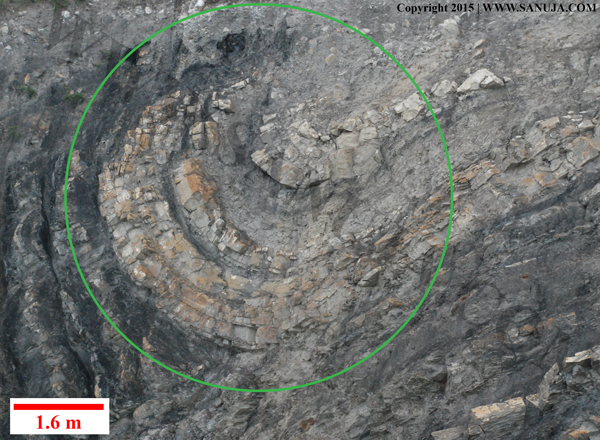
A | deformation that resulted in folding. |
B | deformation that resulted in faulting. |
C | deformation caused by extensional tectonics. |
D | structural feature originated primarily due to an igneous event. |
Question 96 |
A | nitrogen |
B | carbon dioxide |
C | ammonia |
D | water |
E | methane |
Question 97 |
What is 1A on the following diagram? (ID-GLF-24)
Note: DO NOT scroll down to the Geologic Time scale on this page. Answer this question without using any AIDS.

A | Phanerozoic |
B | Pennsylvanian |
C | Proterozoic |
D | Cenozoic |
E | Mesozoic |
Question 98 |

I. Deposition and folding of units 1 to 7
II. Intrusion of the granite pluton
III. Deposition of units A to C
IV. Formation of the unconformity
V. Faulting
VI. Intrusion of the gabbro dyke
A | V (oldest) , III , VI , IV , II , I (youngest) |
B | VI (oldest) , I , III , V , II , IV (youngest) |
C | I (oldest) , II , VI , IV , III , V (youngest) |
D | I (oldest) , III , VI , IV , II , V (youngest) |
E | V (oldest) , II , VI , IV , III , I (youngest) |
F | VI (oldest) , II , III , IV , I , V (youngest) |
Question 99 |
A | R-waves disappeared at the mantle-outer core boundary |
B | S-waves disappeared at the mantle-outer core boundary |
C | L-waves disappeared at the mantle-outer core boundary |
D | P-waves disappeared at the mantle-outer core boundary |
Question 100 |
A | Sandstone |
B | Siltstone |
C | Mudstone |
D | Conglomerate |
Question 101 |
A | hot spots |
B | transform zones |
C | mid-ocean ridges |
D | subduction zones |
Question 102 |
A | slip point |
B | trigger point |
C | focus |
D | epicenter |
Question 103 |
A | Upside down beds (oldest on top) |
B | Faults |
C | Folds |
D | Fractures |
Question 104 |
A | It measures the speed at which the river flows. |
B | It measures the change in capacity of sediment load over a distance. |
C | It measures the elevation change over the distance of flow. |
D | It measures the largest clast/sediment size a stream/river can transport. |
E | It measures the rate at which the transport system deposit its load over a distance. |
Question 105 |
A | stress |
B | strain |
C | shear |
D | deformation |
Question 106 |
A | symmetrical anticline |
B | asymmetrical anticline |
C | asymmetrical syncline |
D | symmetrical syncline |
Question 107 |
A | Earth's crust |
B | Earth's mantle |
C | Radioactive decay within the Earth's core |
D | Friction heat produced at plate margins |
E | Heat absorbed by surface rocks |
Question 108 |
A | 5 - 7km |
B | 40 - 50 km |
C | 15 - 20 km |
D | 1000 - 1500 m |
E | 500 - 1000 m |
Question 109 |
What is 2A on the following diagram? (ID-GLF-24)
Note: DO NOT scroll down to the Geologic Time scale on this page. Answer this question without using any AIDS.

A | Phanerozoic |
B | Pennsylvanian |
C | Cenozoic |
D | Mesozoic |
E | Proterozoic |
Question 110 |
A | carbon dioxide |
B | ammonia |
C | nitrogen |
D | oxygen |
E | water vapor |
Question 111 |
A | Theory of Geologic Evolution |
B | Principle of Uniformitarianism |
C | Theory of Rock Cycle |
D | Principle of Original Horizontality |
E | Theory of Plate Tectonics |
F | Principle of Superposition |
Question 112 |
Precambrian is divided into two Eons as shown on the following diagram as 1C and 1D. What are they? (ID-GLF-62)
Note: DO NOT scroll down to the Geologic Time scale on this page. Answer this question without using any AIDS.

A | Paleozoic and Mesozoic |
B | Proterozoic and Archean |
C | Paleozoic and Phanerozoic |
D | Phanerozoic and Proterozoic |
E | Cenozoic and Mesozoic |
Question 113 |
A | High sediment carrying capacity |
B | Narrow flood plains |
C | Very low stream gradient |
D | Soft substrate with high degree of erosion |
Question 114 |
A | Daily |
B | Yearly |
C | Monthly |
D | Weekly |
Question 115 |
-Deformation
-Faulting
-Folding
-Partial melting
-Foliation
-Metamorphism
-Glaciation
-Erosion
-Sedimentation
A | Glaciation and Sedimentation |
B | Partial melting |
C | Partial melting and Sedimentation |
D | Partial melting, Sedimentation and Glaciation |
E | All of the above can be observed in mountain building processes. |
Question 116 |
A | Deposits of rock fragments and sediments left behind after a glacier has migrated through a region. |
B | Sudden decrease in energy of a river system result in accumulation of the bedloard. |
C | Erosion of high standing sedimentary structures and subsequent deposition of the materials downstream. |
D | Accumulation of microscopic shells and file flakes of clay at the ocean floor. |
E | Deposition of organic matter on terrestrial sediments due to decay of plants and organisms. |
Question 117 |
A | Magnesium |
B | Potassium |
C | Sodium |
D | Calcium |
E | Chloride |
Question 118 |
A | Stratosphere |
B | Troposphere |
C | Exosphere |
D | Thermosphere |
E | Mesosphere |
F | Ionosphere |
Question 119 |
A | The epicenter is the location where a fault slips during an earthquake while focus is the point on the surface of the Earth directly above the focus of an earthquake. |
B | The focus is the geographic location of the seismometer and the epicenter is the physical position of the earthquake. |
C | The term focus is used when the earthquake occur under water/in oceans while the term epicenter is used when it occurs on land. |
D | The focus is the location where a fault slips during an earthquake while epicenter is the point on the surface of the Earth directly above the focus of an earthquake. |
E | They are interchangeable terms used geoscientists to describe earthquakes. |
Question 120 |
What is 3H on the following diagram? (ID-GLF-30)
Note: DO NOT scroll down to the Geologic Time scale on this page. Answer this question without using any AIDS.

A | Devonian |
B | Pennsylvanian |
C | Permian |
D | Jurassic |
E | Cretaceous |
F | Carboniferous |
← |
List |
→ |
| 1 | 2 | 3 | 4 | 5 |
| 6 | 7 | 8 | 9 | 10 |
| 11 | 12 | 13 | 14 | 15 |
| 16 | 17 | 18 | 19 | 20 |
| 21 | 22 | 23 | 24 | 25 |
| 26 | 27 | 28 | 29 | 30 |
| 31 | 32 | 33 | 34 | 35 |
| 36 | 37 | 38 | 39 | 40 |
| 41 | 42 | 43 | 44 | 45 |
| 46 | 47 | 48 | 49 | 50 |
| 51 | 52 | 53 | 54 | 55 |
| 56 | 57 | 58 | 59 | 60 |
| 61 | 62 | 63 | 64 | 65 |
| 66 | 67 | 68 | 69 | 70 |
| 71 | 72 | 73 | 74 | 75 |
| 76 | 77 | 78 | 79 | 80 |
| 81 | 82 | 83 | 84 | 85 |
| 86 | 87 | 88 | 89 | 90 |
| 91 | 92 | 93 | 94 | 95 |
| 96 | 97 | 98 | 99 | 100 |
| 101 | 102 | 103 | 104 | 105 |
| 106 | 107 | 108 | 109 | 110 |
| 111 | 112 | 113 | 114 | 115 |
| 116 | 117 | 118 | 119 | 120 |
| End |
Credits: Based on the excellent class notes provided by, Dr. Gerald Osborn during Fall 2010 and textbook ISBN-978-0-393-93750-3. This version has been updated on between September and December 2015 using excellent class notes provided by, Dr. Glenn Dolphin, Alex Dutchak and Dr. Brandon Karchewski during Fall 2015.
FAQ | Report an Error
Concepts and Additional Questions for Fall 2010 Final
Important!
↑ Some of these are already in the exam type questions in the quiz(above) ↑
Answers to these will NOT be posted. These are based on 2010 lecture notes!
-Know the definitions and features of Composite Volcanos (CV) and Shield volcanos (SV).
-Types of crystallization processes
-Geologic zones; subduction, mid ocean, etc and their features
-Difference between nonconformity and disconformity.
-Difference between stress and strain.
-Differences between tensile stress, compressional stress and shear stress
-Understanding geologic events based on relative deposition.
-Earthquakes and their nature of intensity.
-Types of waves; S-,P-,L- and R- waves.
-Earth’s components and their variation in composition.
-Be able to interpret features on a given map or cross-section.
-Mohorovic discontinuity and it’s importance to geologic studies.
-Know, asymmetrical syncline/anticline, symmetrical syncline/anticline.
-General history of geology as a study subject.
-Concept; slab pull, ridge push and hypothesis on why these occur.
-You should memorize this time scale. Yes, this will most likely appear on the final, but also very useful for the future of your geologic carrier. Most geologists and geophysicsts remember the Geologic Time Scale with respect to important events took place in the history.
